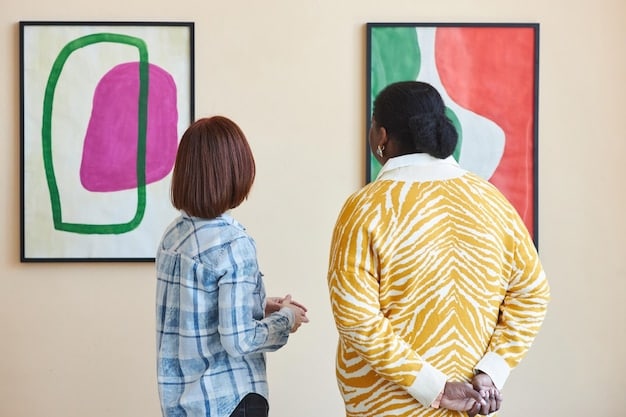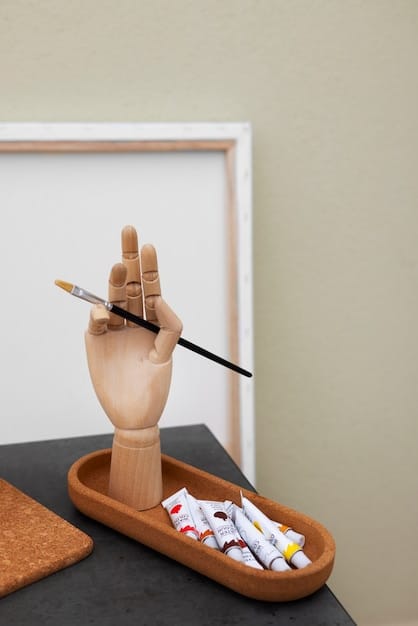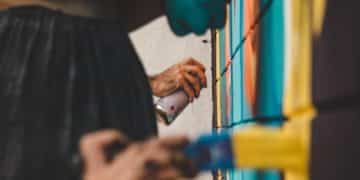How to Get Your Art Noticed: A PR Guide for Artists in the US

How to Get Your Art Reviewed by Major US Publications: A PR Guide offers actionable strategies for artists to effectively present their work to influential media outlets, enhancing visibility and career opportunities in the competitive art world.
Navigating the art world requires more than just talent; it demands strategic promotion. This guide, titled How to Get Your Art Reviewed by Major US Publications: A PR Guide, provides essential steps for artists aiming to gain recognition in the United States.
Understanding the US Art Media Landscape
The first step in getting your art reviewed involves comprehending the diverse media outlets that cover art in the United States. These range from national publications like The New York Times and Artforum to regional art blogs and specialized magazines. Knowing the types of art each publication covers and their audience is crucial for effective targeting.
Identifying Key Publications
Researching which publications align with your art’s style and themes is vital. Look at past reviews and featured artists to gauge if your work would be a good fit. Consider both the prestige and the focus of each publication.
Understanding Editorial Calendars
Editorial calendars can offer insights into upcoming themes and topics that publications plan to cover. This knowledge can help you time your pitches to coincide with relevant features, increasing your chances of getting noticed.
- 🔍 Check publications’ websites for media kits and editorial calendars.
- 🗓️ Plan your PR outreach around the publication’s themes.
- 🎯 Tailor your pitch to align with what the publication is already planning.
Understanding the US art media landscape helps artists strategically target the right publications, enhancing their chances of securing reviews and expanding their audience reach. This initial research lays the foundation for a successful public relations strategy.

Crafting a Compelling Press Kit
A well-crafted press kit is your introduction to journalists and art critics. It should include high-quality images of your work, a detailed artist statement, a biography, and any previous press coverage. The kit needs to be accessible both digitally and physically, ensuring it’s easy for media professionals to learn about you and your art.
High-Quality Images
Professional photographs of your artwork are essential. These images should accurately represent your work and be high-resolution, suitable for both print and online publication. Consider hiring a professional photographer experienced in art documentation.
Artist Statement and Biography
Your artist statement should clearly articulate the concepts, themes, and techniques behind your work. The biography should highlight your artistic journey, achievements, and any relevant background information. Both should be concise and engaging.
- 🖼️ Use professional-grade photography to showcase your art.
- 📝 Write a clear and concise artist statement.
- ⭐ Highlight significant achievements in your bio.
A strong press kit serves as a comprehensive introduction, providing journalists with all the necessary information to understand and write about your art. By ensuring your press kit is professional and informative, you increase the likelihood of securing positive media coverage.
Building Relationships with Art Critics and Journalists
Establishing connections with art critics and journalists can significantly impact your chances of getting reviewed. Attend art events, engage on social media, and introduce yourself to writers whose work you admire. Building genuine relationships can open doors and provide opportunities for your art to be seen and appreciated.
Attending Art Events
Art openings, gallery talks, and museum events are excellent venues for meeting critics and journalists. These events provide a casual setting for initiating conversations and networking with professionals in the art world.
Engaging on Social Media
Social media platforms like Instagram and Twitter offer direct lines of communication with art critics and journalists. Comment on their articles, share their posts, and participate in relevant discussions. Thoughtful engagement can help you get noticed.
- 🤝 Attend art events to network in person.
- 📢 Engage with critics and journalists on social media.
- ✉️ Send personalized emails to introduce your work.
Building relationships with key media figures helps ensure that your art is on their radar. These connections can lead to opportunities for reviews, interviews, and features, greatly enhancing your visibility in the art world.
Crafting the Perfect Pitch
The art of pitching involves presenting your work in a way that captures the attention of busy journalists and editors. A successful pitch is concise, personalized, and highlights the unique aspects of your art. It should clearly articulate why your work is relevant and newsworthy, enticing the recipient to learn more.
Personalizing Your Pitch
Generic pitches are often ignored. Research the journalist or editor you are contacting and tailor your pitch to their specific interests and expertise. Reference their past articles or projects to demonstrate that you understand their work.
Highlighting Unique Angles
What makes your art different? Identify the unique themes, techniques, or perspectives in your work that will appeal to media outlets. Focus on what sets you apart from other artists and why your work is relevant to current cultural conversations.

- ✍️ Keep your pitch concise and to the point.
- 🎨 Highlight what makes your art unique and newsworthy.
- ✉️ Follow up after sending your pitch to show your interest.
A well-crafted pitch significantly increases your chances of securing media coverage. By personalizing your message and highlighting the unique angles of your work, you can capture the attention of journalists and editors, leading to valuable reviews and features.
Following Up and Staying Persistent
Persistence is key in public relations. Following up on your initial pitch is crucial, but it’s essential to do so respectfully and professionally. If you don’t hear back within a reasonable timeframe, a polite follow-up email can keep your work on their radar. Avoid being pushy; instead, offer additional information or context that might be helpful.
Timing Your Follow-Up
Wait about one to two weeks before following up on your initial pitch. This gives journalists and editors time to review your materials. Avoid sending multiple follow-ups in quick succession, as this can be seen as intrusive.
Adding Value in Your Follow-Up
Your follow-up email should provide additional value, such as new information about your art or upcoming exhibitions. This reinforces the relevance of your work and offers a fresh angle for coverage.
- ⏰ Wait a week or two before following up on your pitch.
- 📧 Provide additional information or context in your follow-up.
- 🚫 Avoid being pushy; be respectful of their time and priorities.
Persistence, when coupled with professionalism, can make a significant difference in your PR efforts. By following up thoughtfully and adding value, you demonstrate your commitment and increase the likelihood of securing media attention.
Leveraging Local and Regional Publications
While national publications offer prestige, local and regional media can provide valuable exposure and build a strong foundation for your PR efforts. These outlets are often more accessible and interested in featuring local artists. Building relationships with regional art critics can lead to consistent coverage and recognition within your community.
Identifying Local Art Blogs and Magazines
Research the art blogs, magazines, and newspapers that cover art in your local area. These publications often have a dedicated audience and are looking for stories about local artists. Engage with these outlets and offer them unique content or insights.
Participating in Local Art Events
Local art events, such as gallery openings and art fairs, offer excellent opportunities to connect with regional media. These events provide a platform for showcasing your work and meeting journalists who cover the local art scene.
- 📍 Focus on building relationships with local media outlets.
- ⭐ Participate in regional art events and exhibitions.
- 📰 Leverage local press coverage to build momentum for larger publications.
Leveraging local and regional publications is an effective strategy for gaining initial media attention. By building a strong local presence, you can create momentum that eventually attracts the attention of larger, national publications.
| Key Point | Brief Description |
|---|---|
| 🎨 Media Landscape | Know different art media to target effectively. |
| 🖼️ Press Kit | Prepare high-quality images and a compelling artist statement. |
| 🤝 Relationships | Connect with critics and journalists at art events. |
| ✉️ Perfect Pitch | Personalize your pitch to highlight unique aspects. |
FAQ
▼
A press kit for an artist should include high-quality images of their artwork, a detailed artist statement explaining their vision, a biography, and any previous press clippings or reviews to showcase their work.
▼
Artists can attend art events, engage with critics on social media by commenting on their articles, and send personalized emails expressing interest in their work. Building a genuine connection is key.
▼
A compelling pitch is concise, personalized to the publication and journalist, and highlights the unique aspects or perspectives of the artist’s work. It should grab their attention and make them want to learn more.
▼
Yes, following up is important to show continued interest and to ensure your pitch doesn’t get lost. Wait for a week or two before sending a polite follow-up email expressing your keenness and availability for more information.
▼
Local publications offer a great starting point for artists as they are more accessible and usually have a dedicated local audience. Getting exposure there can help build a foundation before targeting bigger, national publications.
Conclusion
Ultimately, How to Get Your Art Reviewed by Major US Publications: A PR Guide is about strategic planning and persistent effort. By understanding the art media landscape, crafting a compelling press kit, building relationships, pitching effectively, and staying persistent, artists can significantly increase their chances of gaining recognition and elevating their careers in the art world.





